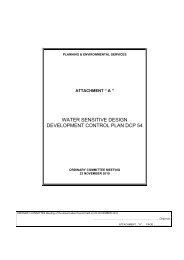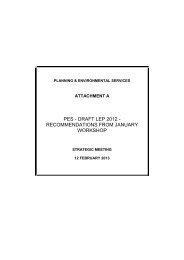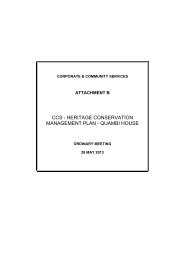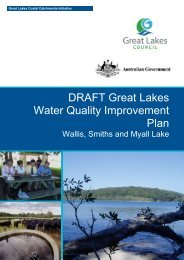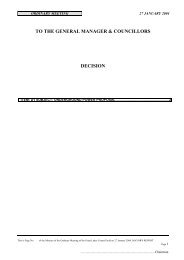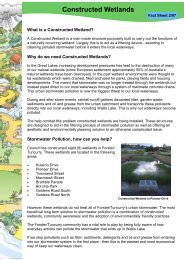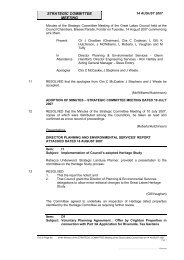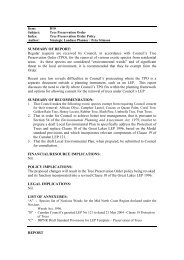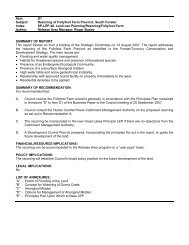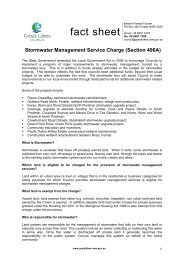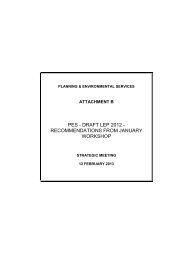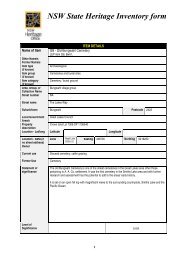13.2 The Wallis Lake Estuary Management Committee - Great Lakes ...
13.2 The Wallis Lake Estuary Management Committee - Great Lakes ...
13.2 The Wallis Lake Estuary Management Committee - Great Lakes ...
You also want an ePaper? Increase the reach of your titles
YUMPU automatically turns print PDFs into web optimized ePapers that Google loves.
<strong>Wallis</strong> <strong>Lake</strong> <strong>Estuary</strong> <strong>Management</strong> Plan<br />
Strategy/Outcome Actions Monitoring and performance indicator Data interpretation Target Comments Progress<br />
Determine baseline water<br />
quality in the <strong>Wallis</strong> <strong>Lake</strong><br />
estuary<br />
W.6.1<br />
N/A<br />
Reduce rural land use<br />
impacts on water quality in<br />
the <strong>Wallis</strong> <strong>Lake</strong> estuary<br />
W.2.1,<br />
W.2.2<br />
Indicators to be measured include; total<br />
nitrogen (TN), total phosphorus (TP), oxidised<br />
nitrogen (NOx), ammonia (NH4), filterable<br />
reactive phosphate (PO4), chlorophyll a, faecal<br />
coliform, temperature, salinity, pH, dissolved<br />
oxygen and turbidity. Sampling to occur at sites<br />
identified in Fig. 4.3 during dry weather, low<br />
flow conditions.<br />
A pilot study should ensure that these sites are<br />
consistent with the Australian Guidelines for<br />
Water Quality Monitoring and Reporting<br />
(ANZECC & ARMCANZ 2000).<br />
Replicate samples are to be taken at each site<br />
and processed at Forster Environmental<br />
Laboratory.<br />
Repeating the monitoring program developed<br />
to establish baseline water quality conditions<br />
on a regular basis each year would allow for<br />
actions designed to improve water quality to be<br />
continually and regularly assessed for their<br />
effectiveness.<br />
Data to be assessed<br />
against set numerical<br />
guidelines in the Australian<br />
and New Zealand<br />
guidelines for fresh and<br />
marine water quality<br />
(ANZECC & ARMCANZ<br />
2000).<br />
Data analysis to be<br />
consistent with the study<br />
design and to be<br />
determined in conjunction<br />
with site selection.<br />
Data analysis as decided<br />
above.<br />
Targets to<br />
be set once<br />
baseline<br />
conditions<br />
determined<br />
This baseline<br />
information is<br />
necessary to set<br />
realistic future<br />
water quality<br />
targets.<br />
Commitment to the<br />
monitoring program<br />
will allow for time<br />
series analysis for<br />
any trends ie.<br />
improving or<br />
deteriorating water<br />
quality.<br />
Regular monitoring<br />
in urban areas<br />
would also allow an<br />
assessment of the<br />
effectiveness of<br />
actions to reduce<br />
impacts of<br />
stormwater on<br />
water quality.<br />
101




